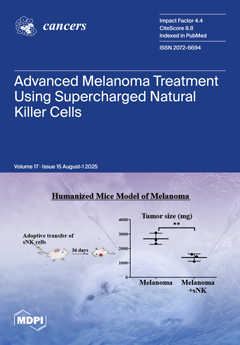Background/Objectives: This study aims to evaluate the additional value of [
18F]F-fluorocholine ([
18F]F-FCH) PET/CT over contrast-enhanced magnetic resonance imaging (CE-MRI) in detecting the recurrence of brain metastases (BMs) after stereotactic radiosurgery (SRS) in patients with lung cancer brain metastases (LCBMs). Methods: Thirty-one patients with suspected recurrence of BM in LCBM after SRS were enrolled in this retrospective study. They underwent both [
18F]F-FCH PET/CT and CE-MRI within 2 weeks. The tumor imaging parameters and clinical features were analyzed. The results of histopathology or radiographic follow-up served as the reference standard for the final diagnosis. Results: In these 31 patients, there were 54 lesions, of which 27 lesions were proven to be BM recurrence, while 27 lesions were non-recurrence. [
18F]F-FCH PET/CT showed high radiotracer uptake in recurrent lesions of BM and identified 24 positive lesions (88.89% of sensitivity), while CE-MRI indicated 23 positive lesions (85.19% of sensitivity). [
18F]F-FCH PET/CT indicated higher specificity (81.48%) and accuracy (85.19%) in detecting recurrence of BM than CE-MRI (40.74% and 62.96%, both
p < 0.05), particularly in frontal lobes and cerebella. For lesion sizes, the accuracy of [
18F]F-FCH PET/CT in detecting recurrent lesions was higher than that of CE-MRI for lesions over 1.0 cm but below 2.0 cm (
p = 0.016). The detective performance of [
18F]F-FCH PET/CT combined with CE-MRI was higher than [
18F]F-FCH PET/CT or CE-MRI alone (all
p < 0.05). Interestingly, TLC (≥4.11) was significantly correlated with poor intracranial PFS (iPFS), meaning it was a significant prognostic factor for iPFS. Conclusions: This study identified that compared with CE-MRI, [
18F]F-FCH PET/CT demonstrated higher specificity and accuracy in diagnosing recurrence of BM in LCBM after SRS. Combining [
18F]F-FCH PET/CT with CE-MRI has the potential to improve diagnostic performance for recurrence of BM and management of patient treatment. TLC was an independent risk factor for iPFS.
Full article






